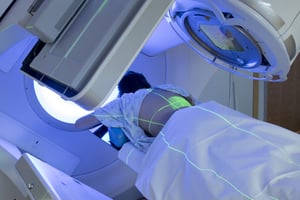 About half of all patients diagnosed with cancer will have radiation therapy included in their course of treatment. However, while radiation is used in an attempt to shrink or eradicate cancerous cells, the surrounding skin and tissue can be damaged. In fact, up to 95 percent of all radiation therapy recipients will develop a skin reaction, known as radiation dermatitis, to some degree. Based on the dose of radiation, beam used, and amount of time the skin is exposed, these injuries can involve the skin, underlying tissues, and even structures as deep as bone.
About half of all patients diagnosed with cancer will have radiation therapy included in their course of treatment. However, while radiation is used in an attempt to shrink or eradicate cancerous cells, the surrounding skin and tissue can be damaged. In fact, up to 95 percent of all radiation therapy recipients will develop a skin reaction, known as radiation dermatitis, to some degree. Based on the dose of radiation, beam used, and amount of time the skin is exposed, these injuries can involve the skin, underlying tissues, and even structures as deep as bone.
Risk of Developing Radiation Dermatitis
Radiation therapy is a fine dance between using enough radiation to destroy the cancerous cells but not so much that serious harm occurs to surrounding healthy tissue. This means limiting prolonged exposure through short, daily treatments in most patients. However, some will require more exposure than others, as well as different types of radiation that can make radiation dermatitis nearly inevitable. Among factors that increase a patient’s risk are:
- Proximity of radiation to the skin
- Energy of radiation
- Radiation dose and schedule
- Size of area to be treated
- Concurrent use of radiosensitizing chemotherapy
In addition to these factors, there are physical attributes that may also make a patient more likely to experience radiation dermatitis, including:
- Obesity
- Existing skin conditions
- HIV
- Diabetes
Treating Radiation Dermatitis
For a population of patients who are already immunosuppressed, any wound represents a very real health threat that must be taken seriously. This means employing the best possible treatment modalities to prevent infection and allow for swift healing. In some cases, prescription ointments or special wound dressings may be enough to allow the skin to fully recover without further intervention. However, in the case of more severe wounds, delayed wounds, or non-healing wounds, hyperbaric oxygen therapy may be needed. During this therapy, the patient will spend time in a pressurized chamber, where 100 percent pure oxygen is used to supercharge the wound healing process and protect against infection. For many with delayed or particularly severe radiation wounds, HBOT represents the only possible effective treatment option.
To learn more about wound treatment after radiation and hyperbaric oxygen therapy in the Baton Rouge area, contact Lane Wound Care & Hyperbaric Oxygen Therapy Center. Our team of experts can help assess the state of the wound and provide the most efficient treatment methods possible to heal and protect the skin.




